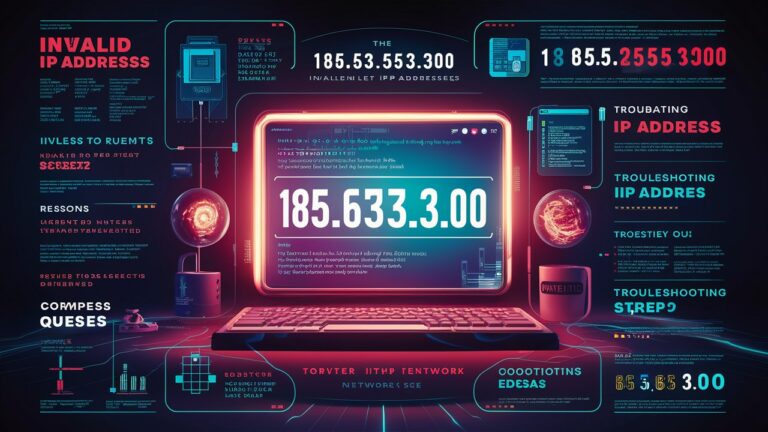In today’s hyper-connected world, IP addresses play a crucial role in how we interact online. But what happens when you encounter an invalid one? Take the case of 185.63.253.300—a seemingly random string of numbers that has left many puzzled and frustrated. Is it a glitch, or is there something more to understand? Join us as we dive into the complexities surrounding this particular address, unraveling common myths and shedding light on technical details that can help demystify your experience with invalid IP addresses. Whether you’re troubleshooting issues or simply curious about how these digital identifiers work, this exploration promises valuable insights for anyone navigating the vast landscape of the internet.
What is an 185.63.253.300?
The string 185.63.253.300 represents an IP address that falls outside the valid range defined by Internet Protocol standards.
IP addresses are typically formatted in a four-part numerical system, with each segment ranging from 0 to 255. When you see “300” as part of an IP address like this, it clearly exceeds the limit.
This particular set of digits may be encountered during internet use but is not routable within the network space because it’s invalid.
An IP address serves as a unique identifier for devices on networks, ensuring data can find its intended destination.
Thus, when faced with something like 185.63.253.300, users often experience issues connecting online or accessing specific services due to misconfigurations or erroneous inputs in software systems.
Common Misconceptions and Myths about Invalid IP Addresses
Many people believe that an invalid IP address simply indicates a technical glitch. While this can be true, it oversimplifies the issue. An invalid IP might stem from user error or misconfiguration rather than just system failure.
Another common myth suggests that all invalid IP addresses are inherently dangerous or malicious. However, many harmless scenarios can lead to an invalid address, such as entering a wrong number or using outdated settings.
Some also think that once an IP is deemed invalid, it cannot be used again. In reality, reassigning and correcting configurations often resolves these issues without permanent consequences.
There’s confusion around IPv4 and IPv6 formats. People may mistakenly assume any incorrect format falls under the same umbrella of problems when they actually follow different sets of rules and structures for valid addresses. Understanding these nuances is vital in navigating network issues effectively.
The Technical Explanation of 185.63.253.300 as an Invalid IP Address
When we examine the IP address 185.63.253.300, it quickly becomes clear that it’s invalid due to its structure. An Internet Protocol (IP) address consists of four octets, each ranging from 0 to 255.
In this case, the last segment exceeds this limit significantly. The number “300” surpasses the maximum allowable value for an octet, rendering it unrecognized in standard networking practices.
Invalid addresses can cause various issues when trying to connect to networks or troubleshoot connectivity problems. Devices rely on correctly formatted IP addresses for communication and data transfer.
Understanding why certain numbers are deemed invalid is crucial for network configuration and management tasks. This knowledge helps prevent errors associated with incorrect addressing schemes in digital environments.
Possible Reasons for Receiving an Invalid IP Address Error Message
Receiving an invalid IP address error message can be frustrating. Several factors could lead to this issue.
One common reason is a simple configuration mistake. If the IP address is incorrectly typed or formatted, it will not be recognized by the network.
Another possibility involves DHCP errors. Dynamic Host Configuration Protocol (DHCP) helps assign IP addresses automatically. If there’s a failure in this system, you may find yourself with an invalid address.
Network hardware issues can also play a role. A malfunctioning router or faulty cables might disrupt communication between devices and prevent valid addresses from being assigned properly.
Conflicts with another device on the network can trigger this error too. When two devices try to use the same IP address, one of them becomes invalid, leading to connectivity problems for both parties involved.
Troubleshooting Tips for Dealing with Invalid IP Addresses
When you encounter an invalid IP address like 185.63.253.300, starting with a few basic checks can save time and frustration.
First, verify that the format is correct. An IP address consists of four octets separated by periods, with each number ranging from 0 to 255.
Next, refresh your network connection. Disconnecting and reconnecting can often resolve temporary glitches that lead to errors.
If issues persist, reboot your router or modem. This action resets the device and may clear any internal conflicts affecting connectivity.
Consider updating your network drivers as well. Outdated software can sometimes misinterpret valid addresses as invalid ones due to compatibility problems.
Consult your internet service provider if the problem continues. They have tools and insights into specific account issues that might be causing the error on their end.
How to Prevent or Fix Invalid IP Address Issues
To prevent or fix invalid IP address issues, start by ensuring your device’s network settings are configured correctly. Check if the automatic IP assignment through DHCP is enabled. This setting allows routers to allocate valid addresses seamlessly.
Updating your router firmware can also help resolve potential bugs that lead to invalid IP messages. Manufacturers often release patches that enhance performance and security.
If you frequently encounter this issue, consider resetting your network equipment. Power cycling your modem and router can clear temporary glitches affecting connectivity.
Using a static IP address might be beneficial in some cases. Assigning a specific address within the correct range prevents overlaps with other devices on the same network.
Regular maintenance of your system software ensures compatibility with networking standards, reducing the chances of encountering such errors again.
Conclusion: Importance of Understanding and Resolving Invalid IP Addresses in the Digital World
Validating and understanding IP addresses is crucial in today’s digital landscape. An invalid IP address like 185.63.253.300 can lead to a cascade of issues, from connectivity problems to security vulnerabilities.
When users encounter an invalid IP address, it often signifies deeper network configuration issues or simple typographical errors. Recognizing these signs early helps mitigate potential disruptions and enhances overall user experience.
Understanding the intricacies of IP addresses not only aids in troubleshooting but also empowers individuals and organizations to optimize their networks effectively. By addressing these technical challenges proactively, we foster a more reliable digital environment for everyone involved.
As technology continues to evolve, remaining vigilant about the details—such as valid versus invalid IP addresses—becomes ever more important in maintaining seamless communication online.

















